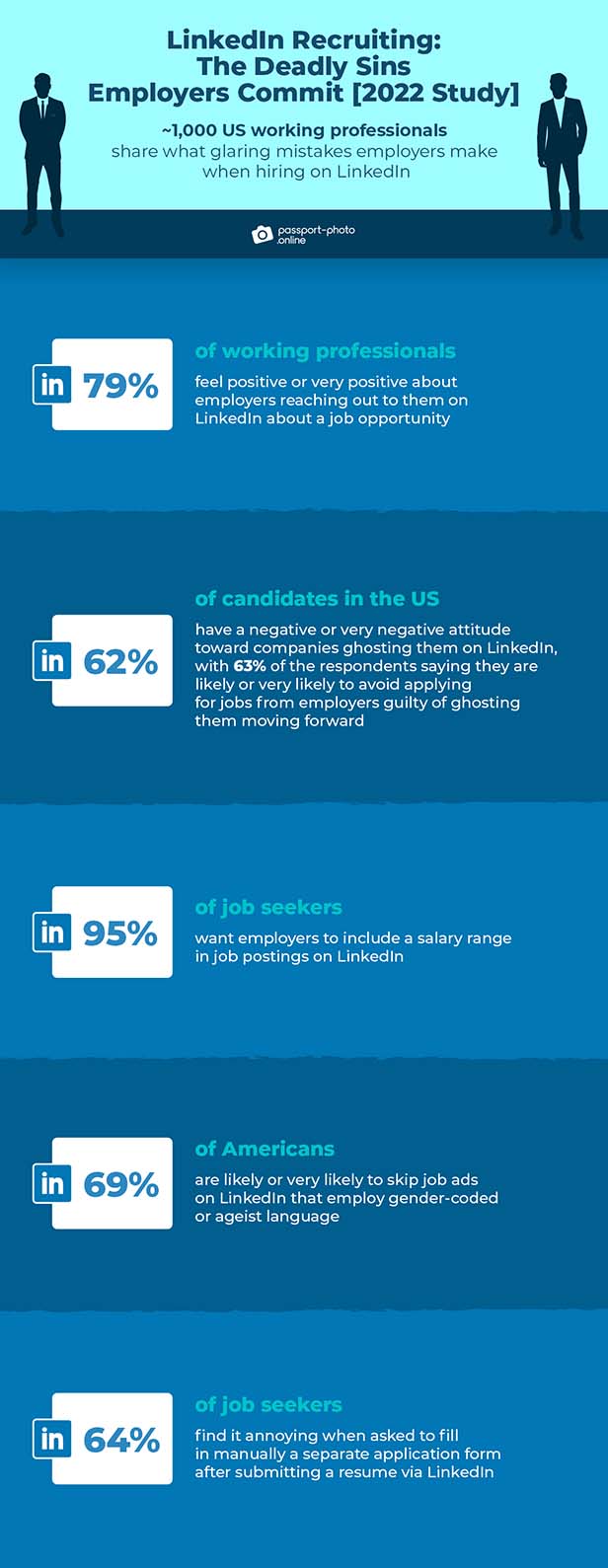June 08, 2022
Why LinkedIn Users May Be Ghosting Your Recruitment Messages
A study finds that professionals like hearing about job opportunities directly from potential employers but tend to ignore generic, impersonal messages that overuse corporate jargon.
LinkedIn is a hot social network for working professionals – particularly job recruiters. In fact, 79% of working professionals feel positive about employers reaching out to them on LinkedIn about a job opportunity, according to a new study.

Despite the majority of LinkedIn’s 66 million users viewing outreach and communication from recruiters favorably, recruiters often miss the mark and potential candidates “ghost” them, Passport Photo Online’s study of over 1,000 U.S. working professionals finds.
Avoid These Recruiting Pitfalls

Key findings from Passport Photo Online’s 2022 LinkedIn Study (Photo: Passport Photo Online)
The reason people ignore LinkedIn recruiters’ messages has a lot to do with context and word choice. Generic, impersonal messages like, “I’ve got an amazing job opportunity that’ll you’ll love,” was the top reason (58%) U.S. working professionals disregard messages.
More than half of the study’s participants also said they ignore recruitment messages if the job opportunity didn’t match their career background (57%), if the company had a poor LinkedIn presence (55%) or if the recruiter overused corporate jargon (52%) and made grammatical mistakes (51%).
On the other hand, over 60% of candidates feel unfavorably when companies ghost them on LinkedIn and moving forward, are unlikely to apply for those jobs where employers have ghosted them.
Most candidates only spend an average of 49.7 seconds on a job posting before clicking away. If the recruiter’s message doesn’t do it, then what makes the position stand out and appeal to job seekers on LinkedIn?
Most notably, the study found that transparency with the salary range in the job description is important to candidates. About 95% of job seekers want employers to include a salary range in job postings on LinkedIn; 69% said they’re likely to skip ads that lack this information. Candidates also reported that the job title, location, summary, type of employment (hybrid, remote, on-site), benefits and key duties are among the top, significant ad details that encourage them to apply to a job posting.
Winning Words & Recruitment Red Flags
Depending on the company and type of candidate that recruiters are looking for, they may decide to use lively, eccentric language in job titles. Employers on LinkedIn, especially those looking to attract millennials and Gen-Zers, have increasingly been using terms like “superstar,” “Jedi” or “rockstar” in job titles. Generally, these tactics are being received favorably by job seekers, with 48% of study participants responding positively and 22% neutrally. (The promotional products industry has its own share of creative job titles – including everything from “creatologist” to “the sultan of swag” – so this should be a stat of particular interest to suppliers and distributors in recruitment mode.)
However, the study finds that certain language, whether done implicitly or intentionally, can deter a candidate from applying. Words like “energetic,” “digital native” or “recent college graduate,” even without harmful intent, can discourage older candidates from applying. Similarly, gender-coded wording like “assert” or “challenge” can be considered masculine and discourage female candidates.
Using ageist or sexist language in job postings on LinkedIn is still common, and 69% of the survey respondents said they’re likely to skip job ads that employ gender-coded or ageist language.
When Your Application Process Is ‘Quite Annoying’
Beyond the initial job posting or recruitment message, employers could also lose potential candidates while they’re in the middle of filling out the job application.

Candidate Expectations in the Application Process (Photo: Passport Photo Online)
After submitting a resume on LinkedIn, there’s often an interview task that candidates must complete. Most U.S. job seekers view this task “quite annoying” (34%). Having to manually fill in a separate application form after submitting a resume via LinkedIn was also viewed unfavorably by candidates (64%).
More and more, a company’s values, ethics and culture are apparent through its social media presence and how recruiters interact with protentional candidates on platforms like LinkedIn. The findings from this study are a helpful roadmap to ensure your first interaction with a prospective employee is a successful one.
